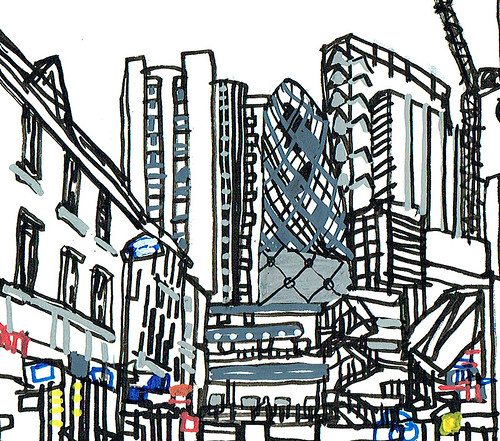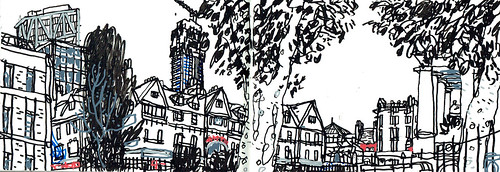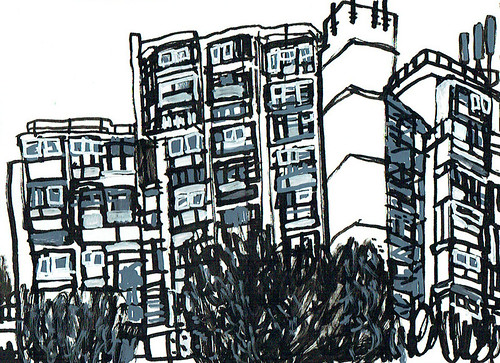This is the third part of a drawing resources guide I created as an assignment as part of my postgraduate study at City, University of London. It doesn't claim to be fully inclusive, and it has a UK focus. There's a link to other parts of the guide at the
bottom of this post, and an introduction to the guide here.
This post features:
Books
Journals and magazines
Television, video and radio
Books
There is a huge range of books about drawing on sale, from the most elementary "how-to" publications to monographs and critical discourse. The selection here focuses mainly on contemporary themes that explore the changing nature and great diversity of drawing through the eyes of writers who are also artists, art tutors, curators and gallerists.
Contemporary drawing: from the 1960s to now (2014), by Katharine Stout, Tate Publishing, London, 169pp, ISBN 978 1854379702
Written by a co-founder of the Drawing Room, London, this book charts the rise of drawing from a preparatory sketch for the main work, to a discipline at the forefront of contemporary art. Stout explores the many routes drawing can take, and its role as externalising thought, and as a means of expression rather than a means to an end, which can involve drawing without paper, perhaps as performance or temporal works. Artists featured extend beyond the Western canon.
Drawing projects: an exploration of the language of drawing (2011), by Mick Maslen and Jack Southern, Black Dog Publishing, London, 240pp, illustrations, ISBN 978 907317255
This book has a practical element of projects with an art school feel – the authors have experience of teaching at foundation and degree level – but insight and advice is included through 19 interviews with leading artists who draw, including Julie Mehretu, William Kentridge, Charles Avery and Jeff Koons.
The drawing book (2005) by Sarah Simblet, Dorling Kindersley, London, 264pp, illustrations, ISBN 978 1405341233
A book of part practical advice and part inspiration and art history, it encompasses information about the materials and techniques that can be employed and insights into the working methods of artists such as Rembrandt, Goya, Blake, Beuys and Basquiat.
The drawing book: a survey of drawing (2007), edited by Tania Kovats, Black Dog Publishing, London, 316pp, illustrations, ISBN 978 1904772330
Based on the Renaissance literary model of the commonplace book (in which noteworthy comments were written), this title explores the place of contemporary drawing through a compilation of works by artists including Louise Bourgeois, Rachel Whiteread, Tracey Emin, Sol LeWitt, Paul MacCarthy and Paul Noble that explore five themes: measurement, nature, the city, dreams and the body. It includes essays by curators and art writers.
Drawing now: between the lines of contemporary art (2007), edited by Simon Downs, Russell Marshall, Phil Sawdon, Andrew Selby and Jane Tormey, I.B. Tauris, London and New York, 128pp, illustrated, ISBN 978 1845115333
Drawings by 43 artists, including Tracey Emin, Paul Noble, Cornelia Parker, David Shrigley and Erwin Wurm, whose works typically are manifested through the practice of drawing.
Line let loose: scribbling, doodling and automatic drawing (2013), by David MacLagan, Reaktion Books, London, 176pp, illustrations, ISBN 978 1780230825
MacLagan traces the history and evolution of the three marginal forms of drawing – scribbling, doodling and automatic drawing – which embrace Surrealism, Abstract Expressionism, Psychedelic art and works by artists including Jackson Pollock, Paul Klee and Sol LeWitt as well as the less familiar and anonymous.
The primacy of drawing: histories and theories of practice (2010), by Deana Petherbridge, Yale University Press, 352pp, illustrations, ISBN 978 0300126464
Petherbridge, an artist whose work focuses on drawing, explores its role as "visual thinking" from the 15th century to the present day, and drawing's primal importance in generating ideas and problem solving. She argues that drawing has its own discrete place in artistic practice, its own codes, systems, materials and economy.
Vitamin D: new perspectives in drawing (2005), by Emma Dexter, 352pp, illustrations, ISBN 978 0714857138
Vitamin D2: new perspectives in drawing (2013), by Christian Rattemeyer, 352pp, illustrations, ISBN 978 0714865287
Vitamin D features the work of 109 contemporary artists selected by leading critics and curators, with work that reflects the current state of drawing as a medium. Vitamin D2, published 12 years later, did the same again, featuring 115 new artists from 40 countries who had become established during that interlude. Between them, the books are an excellent survey of contemporary drawing practice.
Walk the line: the art of drawing (2013), by Marc Valli and Ana Ibarra, Laurence King Publishing, London, 320pp, illustrations, ISBN 978 1780671109
Drawings by – and interviews with – 84 international artists who don't see drawing as a preparatory work or route on the way to another piece of work, but as a finished medium in its own right, and who often work on a large or even monumental scale.
Journals and magazines
The Drawer: revue de dessin
www.thedrawer.net
First published 2011
The Drawer, a French publication that takes its homonymous name from a person who draws and a place to store drawings, is published every six months. It features drawings in its widest sense, from artists, designers, architects and illustrators, to singers, musicians, choreographers and authors, who also answer a brief series of questions. Each issue takes as its theme the title of a book, film or piece of music with creative potential.
Drawing: Research, Theory, Practice (DRTP)
www.ingentaconnect.com/content/intellect/drtp
First published 2016
This peer-reviewed journal focuses on contemporary practice and its theoretical context, and aims to re-establish the "materiality" of drawing during an age of electronic media. Topics include papers as well as visual contributions.
Eye
www.eyemagazine.com
First published 1990
This is a quarterly international review of graphic design and visual culture. As well as colour images, it features in-depth articles on illustration, design and visual culture.
 Fukt
www.fuktmagazine.com
Fukt
www.fuktmagazine.com
First published 1999
Fact (see image) is an annual magazine for contemporary drawing that was founded in Norway in 1991 and based in Berlin since 2001. It focuses on artists' drawings with occasional interviews and essays. Each issue comes in a different design and format.
Graphite
www.graphitemag.com
2016-January 2019
A quarterly independent print magazine about concept drawing, urban sketching and illustration that brought together well-illustrated interviews and information about the techniques used, which despite the title, was not restricted to pencil.
HB
www.revue-hb.org
First published 2013
HB presents contemporary drawing practices as a "kind of exhibition on paper", and features emerging, marginalised and established artists from Quebec, Canada, where it is based. It gives precedence to imagery made using graphite, ink and coloured pencil rather than text. The initiative is run by five Canadian artist-run centres and a commercial gallery.
Open Arts Journal
openartsjournal.org
First published 2013
Published by the Open University, this peer-reviewed open access journal for arts scholarship spans practitioners in such communities as art, architecture and design, curators and arts policy makers, and researchers in the arts and heritage sectors. Each contribution is published under a Creative Commons (CC BY-NC 3.0) licence. Five issues have been published since its first in 2013, each taking on a theme.
Tracey
www.lboro.ac.uk/microsites/sota/tracey/journal
First published 1999
An online, open access, peer-reviewed journal hosted by Loughborough University School of Art and Design that is an arena for discussion and debate and research on contemporary drawing and visualisation.
Television, video and radio
Learning on Screen TV programmes were accessible through education institutions (UK only) on Box of Broadcasts (subscribers only) on 25 April 2017.
The Big Draw YouTube channel
www.youtube.com/channel/UCBlRud0vgE6CxfEns9UylNw [Accessed 25 April 2017]
A selection of videos by the organisers of the annual Big Draw Festival (see page 6) that feature conversations with prominent drawers, and visits to artist-led drawing events.
Inside the Life Drawing Class
14 December 2010, BBC Radio 4, 30 mins
learningonscreen.ac.uk/ondemand/index.php/prog/0184D7F2
The re-emergence in popularity of drawing the naked human figure is explored and encouraged by the art graduate and TV presenter Anneka Rice.
Life Class: Today's Nude
2012, Channel 4, 30 mins
learningonscreen.ac.uk/ondemand/index.php/prog/0106D039
A series that gives viewers the chance to draw life models with a different well-known artist tutor for each task, including Gary Hume, Maggi Hambling and Humphrey Ocean.
Reportager Vimeo channel
vimeo.com/user45892159 [Accessed 25 April 2017]
A series of short films that focus on the work of documentary artists that give an insight into working practices and inspirations.
The Secret of Drawing
2005, BBC2, 60 mins
learningonscreen.ac.uk/ondemand/index.php/prog/0055190F
A four-part series in which Andrew Graham Dixon explores the history of drawing and how it has been used by designers and architects.
Urban Sketchers YouTube channel
www.youtube.com/channel/UCAKqvBoCajSJFnnmEo2t0-w/featured [Accessed 21 December 2017]
The official YouTube channel of the Urban Sketchers organisation features videos about its workshops, symposiums, sketchcrawls, news and events, shares videos of its regional groups, and educates viewers about the practice of drawing on location.
Ways of Seeing
2008, BBC4, 30 mins
learningonscreen.ac.uk/ondemand/index.php/prog/00047517
The seminal four-part TV series presented by the writer John Berger originally shown in 1972, and which was adapted as a book of the same name, raises questions about how we look at works of art, and therefore how we make them.
What Do Artists Do All Day?
2013-15, BBC4, 30 mins
learningonscreen.ac.uk/ondemand/index.php/prog/070EBAFF
A documentary series that traces the everyday routines and working processes of prominent artists, including Cornelia Parker, Michael Craig-Martin and Peter Blake. The three series consist of 22 episodes in total.
Missed the others in this series?
Here is the first one (introduction, online resources, electronic resources),
here is the second (drawing organisations, museums, galleries and libraries),
and here's part four (drawing schools, prizes and awards, and suppliers).
 Trinity Buoy Wharf Drawing Prize (previously Jerwood Drawing Prize)
Trinity Buoy Wharf Drawing Prize (previously Jerwood Drawing Prize)








